Assessing Ike's impact on DVMs could take weeks
AUSTIN, TEXAS - "It's no exaggeration to liken this to a bombing site. That's how bad the destruction is," says Dr. Elbert Hutchins, executive director of the Texas Veterinary Medical Association (TVMA).
AUSTIN, TEXAS — "It's no exaggeration to liken this to a bombing site. That's how bad the destruction is," says Dr. Elbert Hutchins, executive director of the Texas Veterinary Medical Association (TVMA).

Amid the ruins: Some Galveston residents survey what's left of their homes and other structures on the island city.
He was talking about the Houston-Galveston-Beaumont area in the days after Hurricane Ike — a storm virtually as big as Texas itself — tore through the region the night of Sept. 13, carving a swath of death and destruction. It was blamed for 61 deaths, including 26 in Texas.
Just how many veterinary practices were affected and to what extent wasn't fully known at press time — about 10 days after the storm — and might not be fully determined for weeks to come.
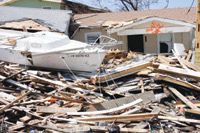
Devastation: The hurricane's direct hit wiped out almost everything on Galveston Island.
"We're still in the assessment stage, trying to determine the full scope of it on the veterinary side," Hutchins tells DVM Newsmagazine.
"We're looking at practices, livestock losses and rescue, pet rescue, wildlife and other aspects. It's going to take quite some time. A lot of people are still without power — that's one of the biggest problems — and there's a lot of standing water," he says.

Helping hand: A Galveston volunteer tends to a dog at a Humane Society shelter.
"Throughout Galveston County and Houston, including the smaller towns, probably 150 to 200 veterinarians were impacted in some way, some of course more than others," Hutchins says, adding that emergency veterinary operations were organized in about a dozen counties.
Most veterinary practices the TVMA or other agencies contacted within a week after the storm were still standing but without power, Hutchins says.
That's essentially what Beaumont veterinarian Arden E. Read told DVM Newsmagazine in an e-mail on Sept. 18. He wrote:
"We are very fortunate at Animal Medical and Surgical Hospital in Beaumont, as we sustained minimal damage to our office and should be back in business when our power is back in a few more days," Read says.
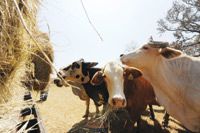
Emergency rations: Agriculture and livestock groups collected hay for livestock displaced on hurricane-ravaged Bolivar Island near Galveston.
"I was able to go to my hospital as soon as the wind died down to tropical-storm force to check on a few critical patients, and I have been able to go in every day since. But I haven't been able to contact any of my colleagues yet to see how they fared."
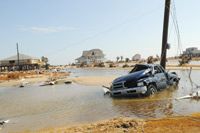
DVM Newsmagazine staff members had similar difficulties contacting veterinarians. Dozens of telephone calls to practices were unanswered or produced busy signals, and e-mails were unanswered.
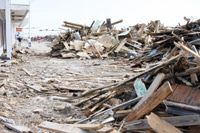
Devastation east of I-45
Hutchins uses Interstate 45 as a reference point in describing the storm's path of destruction. "Interstate 45 runs in a south-southeasterly direction from Dallas to Houston and on down to Galveston. Essentially it bisects Houston. Everything east and southeast of I-45, stretching all the way down to Beaumont near the Louisiana border, was hardest hit — with the most flooding, most trees down. That's the area likely to be without power the longest. Power restoration will likely take place starting west of Houston and moving east."
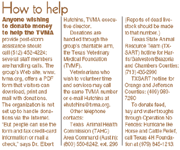
How to help
Galveston and the Bolivar Peninsula took the brunt of the storm and sustained the most damage. Galveston officials sought $2.3 billion in federal aid.
Houston's ship channel runs through that city's eastern side, which is lower in elevation, helping to account for the heavier flooding there.
Standing water was a growing concern at press time. State entomologists say mosquitoes breeding in stagnant water will emerge in a few weeks, and could carry vectors for diseases like Eastern equine encephalitis and West Nile virus. Many areas were being sprayed to reduced that threat.
The Texas Animal Health Commission (TAHC), which regulates the state's livestock and poultry, reports that shelters took in more than 550 livestock and about 1,200 small animals.
U.S. Department of Agriculture representatives and the TAHC reported observing large numbers of cattle and horse carcasses, and that many large animals roamed freely. A consortium of agriculture and livestock groups formed Operation No Fences: Hurricane Ike Horse and Cattle Relief to collect donations of hay, feed and water troughs.
The Texas State Animal Resource Team (TXART), the disaster-response unit within the Texas Veterinary Medical Foundation (TVMF), works primarily with small-animal issues, supporting local government needs such as animal shelters and some nonprofit shelters.
"We've been extremely busy, with only myself and two others working up and down the Texas coast between Galveston and Beaumont," Elizabeth Serca, TXART executive director, tells DVM Newsmagazine. "The Texas emergency management team deserves a lot of credit in helping keep down the number of animals we had to deal with, by allowing owners to take pets with them when they evacuated," Serca says. In the Katrina evacuation of 2005, many people refused to evacuate because they couldn't take pets with them.
"We just finished our work in Chambers County (Anahuac) today (Sept. 23). We worked with an emergency shelter there helping reunite some pets with their owners. So things are calming down somewhat now, but there's still work to do in Galveston County and Beaumont," Serca says.
Cash, volunteers needed
Volunteer help is welcome, she says, but explains that people need to work with reputable groups and have prior clearance. Well-meaning persons who simply show up present safety and accountability problems, she says.
Veterinary help is much needed, Serca says, adding that veterinarians would have no problem getting credentials.
The TVMA says cash donations are what's needed most to help the veterinary community, primarily for things like generators and fuel.
"We've bought several generators, which are in short supply, and they cost about $1,000 per installation. Our organization doesn't have the budget for it, but we're doing it anyway," Hutchins says.
The 5.5-kilowatt generators helped DVMs who have wells to draw the water they need, and provided some lighting, refrigeration and air-conditioning. They were being distributed on a most-needed basis to veterinarians on a waiting list," Hutchins said at press time. "We just ask them to commit to use them to help during the emergency at their facility or another one."
Overall, the state's veterinary organizations, animal-welfare groups and human relief agencies seemed well prepared, Hutchins says.
One example was at College Station, about 100 miles north of Houston and home to Texas A&M University. "Things worked very well" at two shelters there, says Angela G. Clendenin, director of communications and public relations for the university's College of Veterinary Medicine and Biological Sciences.
The college worked with the Brazos County Emergency Management Team and Brazos Animal Shelter in advance to set up the shelters, one for small animals and another for horses and livestock.
The large-animal sheltering plan was believed to be unique among the Texas evacuation hubs (others were in Austin, Waco and Dallas-Fort Worth). It was equipped to handle up to 200 horses, 80 cattle and 80 small ruminants and pigs, and was nearly filled to capacity on the eve of the storm.
Humane organizations helping in the rescue of stranded animals were well organized with some mobile units and "generally seem to have the basics of what they need, but they definitely can use veterinarian volunteers," Hutchins says.